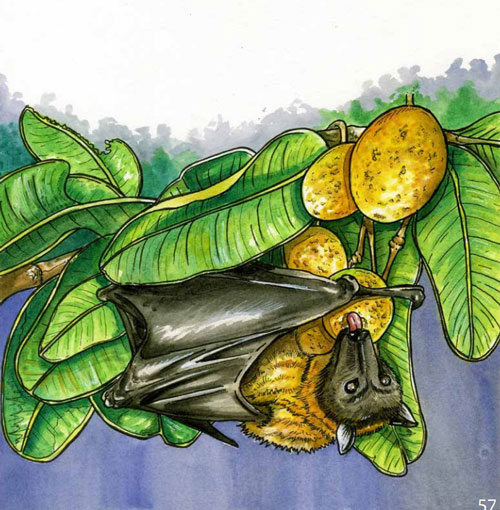The US Fish and Wildlife Service recently announced a list of 21 species formally declared extinct. And while any species extinction is distressing, it was with great sadness that I heard the news of a particular species featured in one of my picture Books.
Farewell, Little Mariana Fruit Bat
The Little Mariana Fruit Bat, Pteropus tokudae, was one of the species removed from the endangered due to extinction by the US Fish and Wildlife Service. The last known sighting of the bat was in 1968. Since the population of its related bat species, the Mariana Fruit Bat, Pteropus mariannus mariannus, has steadily declined, scientists assumed any remaining colonies on Guam of the Little Mariana Fruit Bat would have also reduced. Both species had similar roosting and feeding behaviors. In addition, these bat species only had a few offspring with extended periods of care, adding to the difficulty of growing their populations.
The Little Mariana Fruit bat was a tiny megabat. The wingspan was 25-29 inches. Its coloration is described as dark brown with a golden or brown mantle, throat, and neck. The top of the head was gray or golden. The food included flowers and fruit.
The reasons given for the extinction were hunting and habitat changes. However, I suspect the ecological disaster brought about by the introduction of the brown treesnake also contributed to the demise of these bats.
I wrote about the destruction caused by the brown treesnakes. Including the birds and bats driven to extinction in Guam: Return of the Songs. Below is an excerpt about the related Mariana Fruit Bat. The English text was also translated into CHamoru, the language of Guam, by Rosa Salas Paloma. The illustration was by Lucille Ronquillo.

Pteropus mariannus mariannus Mariana Fruit Bat
Mariana Fruit Bat Pteropus mariannus mariannus
Fanihen Mari’åna
The fanihi, Mariana Fruit Bat, are colored in shades of brown.
Lehngon kulót chukulåti i fanihi siha.
It prefers jungles and cliffs that don’t have people around.
Ga’ña-ña hålom tåno’ yan kantít siha nu i taya’ taotao gi i iriya.
However, some people like to eat the bat,
Lao, guaha na taotao gumuaiya kumånno’ i fanihi.
But disease-causing toxins can be found in its fat.
Lao guaha binenu siha siña masodda’ gi i mantikå-ña.
They look like foxes with large eyes and ears that are round;
Kulan ga’lågon machålek pusision-ñiha yan dångkolo ataddok-ñiha yan aridondon talangan-ñiha.
They are the only kind of bat that on Guam is still found.
Siha ha’ na klåsen fanihi siña masodda’ gi iya Guåhan
Why does the loss of this bat species matter? It was part of an interdependent ecosystem. Plants that these bats pollinated and whose seeds they dispersed are now forever deprived. The nutrients provided by their guano are now absent. Another piece of Guam’s environment is gone forever. While it may be too late for this species, there are other species we can work to conserve. Check out my conservation books and workbooks to learn more.
